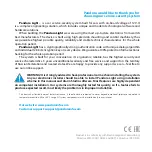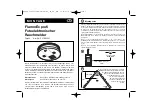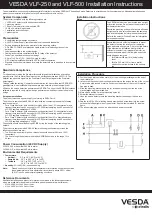
Detector Placement
This section of the manual discusses the placement of projected beam
detectors.
Though this information is based upon industry expertise, it is intended to be
used only as a technical guide. Always comply with the requirements of
applicable codes and standards such as, NFPA 72, National Fire Alarm Code,
BS 5839-1 NFS 61.970, R7, AS1670.1 and GB50166, etc. as well as directives
of the Authority Having Jurisdiction (AHJ). For general information on the
placement of detectors, read OSID Global Application Note, document no.
(25686).
Projected beam detectors are usually located with their beams parallel to the
ceiling. However, they can be mounted vertically or at any angle to protect
the area involved. Since beam detectors sense the smoke build- up over a
distance, they are ideal for locations with high ceilings. They can also be
mounted on a wall or ceiling below the level of a spot type detector, reducing
the effects of air stratification. Some typical locations would include large
areas with high ceilings such as atriums, warehouses, and factories.
Note:
Projected beam smoke detectors should always be mounted to
stable mounting surfaces. For more information refer to
sections Mounting Locations.
Some fire codes specify spacing on a given centre-to-centre distance between
detectors under ideal conditions. This spacing is based on rooms with smooth
ceilings and no physical obstructions between the contents being protected and
the detectors. Moreover, they are also based on a maximum ceiling height, and
on the assumption that the value and the combustible nature of the contents of
the room being protected do not warrant greater protection or closer spacing.
Example for spacing according to
NFPA 72
As an example for NFPA 72, in a room with a smooth ceiling, detectors
should be spaced horizontally between 30 and 60 feet (9.1 to 18.3m). One-half
that spacing between the beam and the sidewall may be used as a guide. See
Figure 3-3. The beam detector can be mounted with the transmitter/receiver
on one wall and the reflector on the opposite wall, or both suspended from the
ceiling, or any wall/ceiling combination. In the case of the ceiling mount, the
distance from the end walls should not exceed one- quarter of the selected
spacing (7.5 ft. [2.3m] maximum if the spacing is 30 ft. [9.1m]). See Figure
3-4.
12” minimum
(0.3m)
10’ (3.0m)
minimum
Typical
30’ (9.1m) maximum
To First
Detectors
1/2 S
S
Wall
Figure 3-3: Smooth Ceiling (Side View)
1/2 S maximum
Reflector
Tx/Rx
S
Tx/Rx
Reflector
16 ft. (5m) minimum
328 ft. (100m) maximum
1/4 S
maximum
Figure 3-4: Smooth Ceiling (Top View)
In the case of peaked or sloped ceilings, codes may specify spacing of
detectors by using horizontal spacing from the peak of the roof or ceiling.
Figure 3-5 and Figure 3-6 show the spacing for both the shed type and peaked
type sloped ceilings.
On smooth ceilings, beam smoke detectors should generally be mounted a
minimum of 12 inches (0.3m) from the ceiling or beneath structural
obstructions such as joists, ducts, etc. See Figure 3-3 In addition, beam smoke
detectors should be mounted vertically at least 10 feet (3.0 m) from the floor
to avoid common obstructions from normal building usage. In many cases,
however, the location and sensitivity of the detectors shall be the result of an
engineering evaluation that includes the following: ceiling heights above 30
feet (9.1 m) – refer to OSID Global Application Note, document no. (25686)
for more information regarding the effects of stratification, structural
features, size and shape of the room and bays, occupancy and uses of the area,
ceiling height, ceiling shape, surface and obstructions, ventilation, ambient
environment, burning characteristics of the combustible materials present, and
the configuration of the contents in the area to be protected.
As a rule, reflective objects such as ductwork or windows should be a
minimum of +/- 2° out of the center of the beam path of the beam.
Reflector
S
S
3 ft. (0.9m)
maximu
m
1/2 S
maximum
Tx/Rx
Figure 3-5: Sloped Ceiling (Shed Type)
7
E56-6965-000


































